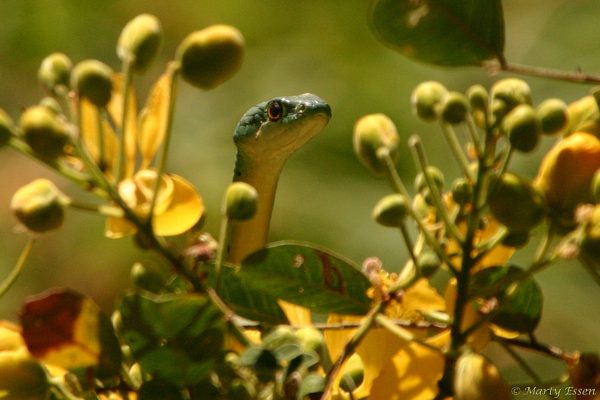
Marty’s photo of the day #2539: This excerpt from my first book, Cool Creatures, Hot Planet: Exploring the Seven Continents, explains today’s picture:
I was looking forward to a nap until Ashley, the camp manager, mentioned over lunch that she had recently seen both a Mozambique spitting cobra and a spotted bush snake on the camp’s grounds. No way could I sleep now. I quickly finished my meal and began my search. Poor Brian; he could have used a nap like everyone else. But with a cobra in the area, he felt obligated to accompany me.
Finding the spotted bush snake was easy. First, we checked the last place Ashley saw it. When it wasn’t there, we walked toward the open-air lounge just in time to see it glide across our path and crawl into a mass of shrubbery.
I feared the snake had disappeared for good and was surprised when he stuck his head out the top of a shrub to check me out. He looked as if he were saying, “Hi, I’m a spotted bush snake, what are you?”
After shooting the snake’s portrait, I debated whether to catch him. I turned to Brian and asked, “Is he venomous?”
“I don’t think so, but he may be rear fanged with mild venom.”
The thin three-foot-long snake was bright green with specks of black. He was one of the prettiest snakes I’d ever seen. He also closely resembled one of the glamour snakes on my list: the deadly boomslang.
I flashed back to my experience on the island of Borneo when I picked up the incorrectly identified, highly venomous banded coral snake. Consequently, I decided a cautious capture attempt would be my best approach. If the snake gave me a clear path to his head, I’d grab him. Otherwise, I’d let him be.
Halfhearted efforts are seldom successful. When I reached for the snake, I hesitated for the tiniest moment. That was all he needed to avoid my grasp and retreat into the shrubbery.
Since the snake was out of reach, I stepped over to the lounge library and grabbed the Field Guide to Snakes and other Reptiles of Southern Africa. I confirmed the snake’s identity by comparing the photo in the book with the image on my digital camera screen. Next, I turned to the photo of the boomslang. The spotted bush snake was a close mimic indeed. Head shape (a boomslang’s head is rounder) and a subtle variation in markings were the only differences I could see between the snakes.
Spotted bush snakes don’t have venom glands, but according to A Field Guide to the Reptiles of East Africa, their saliva appears to be toxic to frogs. This got me to thinking: perhaps in its quest to mimic the boomslang, the spotted bush snake may continue its evolution and someday develop venom glands of its own.
Our search for the spitting cobra was unsuccessful. I did, however, encounter another mimic. I was crossing the grass between the lounge and the cabins when a water pipe, protruding from the ground, froze me in my tracks. The spigot atop the vertical pipe was at the perfect angle to create the illusion of a hooded-up cobra, ready to spit.